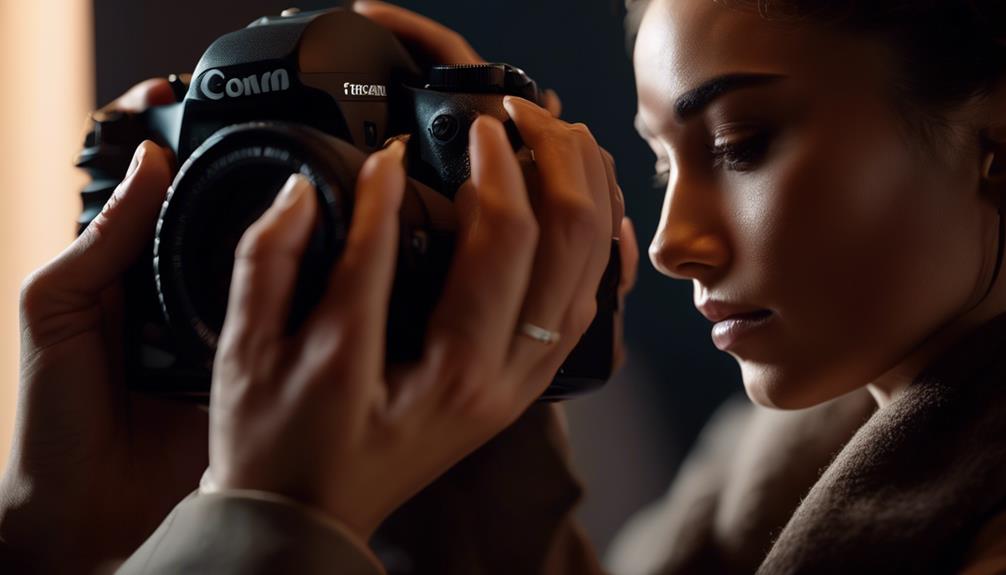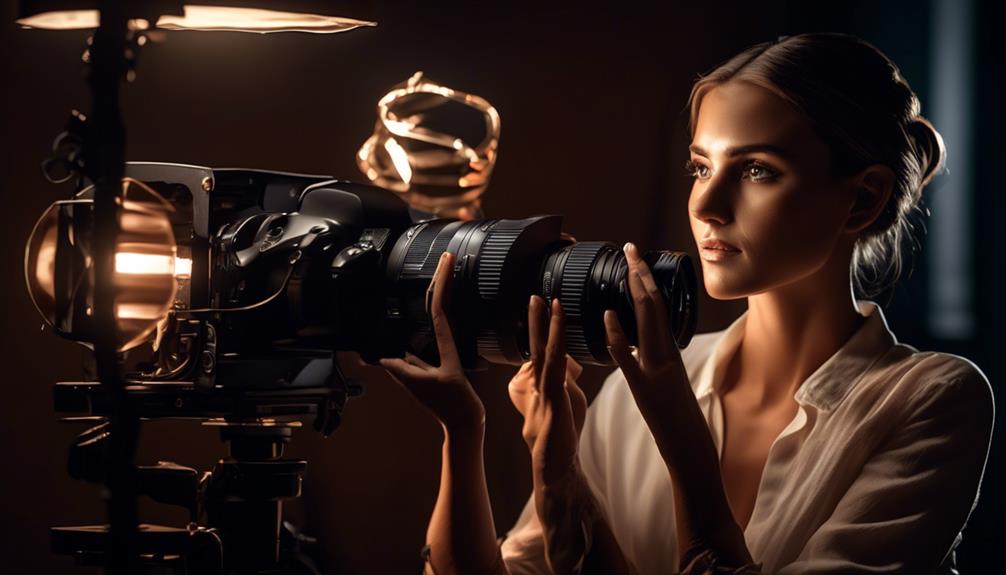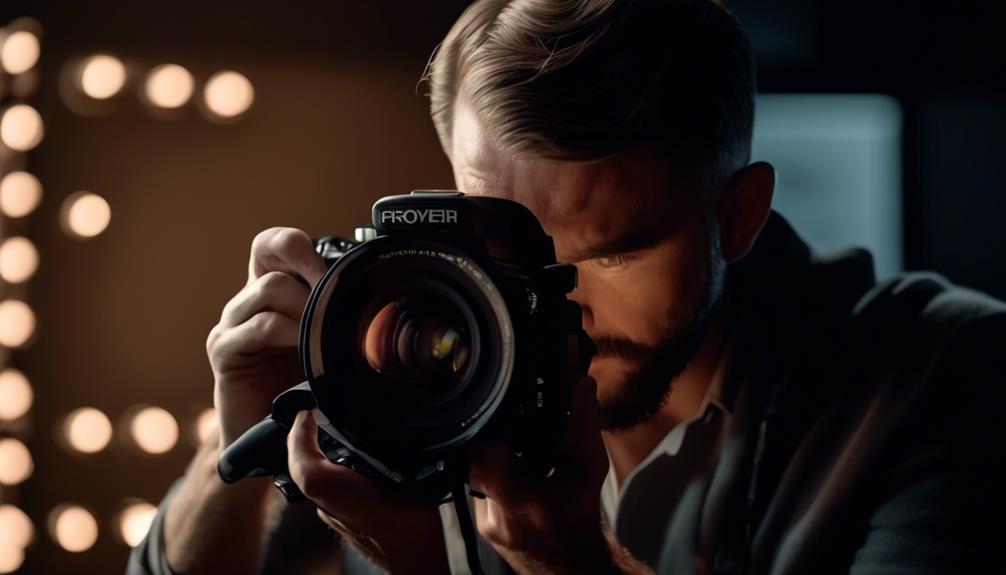Please note this post may contain affiliate links picked by me (Jay) that I have deemed may be of interest or relevant to you the reader of this.
These links do not affect the cost of the thing if you decide to purchase but i may get a little money if you choose to purchase.
For more information on my affiliate link policy click here.
Imagine this: you're in a dimly lit room with a subject who is expecting you to capture their essence in a portrait. The pressure is on, and you need to make sure your lighting skills are up to par.
So, what techniques can boost your portrait lighting skills and help you create stunning images that truly showcase your subject? Well, let me tell you, there are several key techniques that can take your portrait lighting game to the next level.
From understanding and mastering different lighting equipment to harnessing the power of natural light and exploring the world of off-camera flash, there are endless possibilities to enhance your portrait lighting skills.
But that's not all. We'll also delve into the realm of lighting modifiers and studio lighting techniques that can transform your portraits into works of art.
So, if you're ready to elevate your photography game and capture the true essence of your subjects, keep reading.
Key Takeaways
- Different lighting setups create various effects, so experimenting with different setups is important for finding the desired style.
- Adjusting lighting ratios adds depth and dimension to portraits, allowing for more control over the intensity and mood of the image.
- Studio lighting techniques provide complete control over light sources and modifiers, resulting in stunning and professional-looking portraits.
- Understanding the subject's skin tone and using appropriate light sources and positioning is crucial for effective portrait lighting.
Understanding Lighting Equipment
When it comes to mastering portrait lighting, understanding your lighting equipment is essential. Whether you're a professional photographer or just starting out, knowing how to utilize your lighting equipment can make a significant difference in the outcome of your portraits. In this article, we'll delve into the world of lighting setups and explore the importance of understanding your equipment.
To begin with, having a clear understanding of your lighting equipment allows you to create the desired mood and atmosphere in your portraits. Different lighting setups, such as using softboxes or umbrellas, can help you achieve various effects. For example, a softbox creates a soft and diffused light, ideal for capturing a gentle and flattering portrait. On the other hand, using a harsher light source like a beauty dish can create more dramatic and edgy portraits. By experimenting with different lighting setups, you can find the style that best suits your artistic vision.
Moreover, understanding your lighting equipment enables you to have control over the lighting ratios in your portraits. Lighting ratios refer to the relationship between the main light, fill light, and background light. By adjusting the intensity and positioning of each light source, you can create depth and dimension in your portraits. This technique allows you to emphasize certain features or hide imperfections, ultimately enhancing the overall composition.
Mastering Natural Light Techniques
Now that we've a solid understanding of our lighting equipment, let's shift our focus to mastering natural light techniques. Natural light can create stunning portraits, and with the right techniques, we can take our photography to the next level.
Here are five techniques that will help you harness the power of natural light:
- Balancing ambient light: One key aspect of using natural light is understanding how to balance it with the existing ambient light in your environment. This can be achieved by adjusting your camera settings or using reflectors to bounce and soften the light.
- Enhancing backlighting techniques: Backlighting can add a beautiful and dramatic effect to your portraits. To enhance this technique, position your subject between the light source and your camera, allowing the light to create a halo effect around them. Experiment with different angles and compositions to achieve the desired look.
- Using window light: Window light is a fantastic natural light source that can create soft and flattering portraits. Position your subject near a window and use curtains or blinds to control the intensity and direction of the light. You can also experiment with different times of the day to capture unique lighting effects.
- Embracing golden hour: The golden hour, which occurs during the first and last hour of sunlight, provides a warm and magical glow. During this time, the light is softer and more diffused, resulting in stunning portraits. Plan your shoots accordingly to make the most of this beautiful natural light.
- Incorporating natural reflectors: Nature provides us with various natural reflectors that can enhance our portraits. Look for surfaces like water, sand, or white walls that can bounce light back onto your subject. By strategically placing your subject in relation to these reflectors, you can achieve a more balanced and well-lit portrait.
Mastering these natural light techniques will give your portraits a unique and professional touch. So, grab your camera, explore the power of natural light, and watch your photography soar to new heights!
Utilizing Off-Camera Flash
Let's dive into the world of off-camera flash and discover how this powerful lighting technique can elevate your portrait photography.
When it comes to creating stunning portraits, off-camera flash can be a game-changer. It allows you to have complete control over the lighting, giving you the freedom to shape and enhance your subject in unique and creative ways.
One of the key advantages of off-camera flash is the ability to experiment with creative positioning. Unlike natural light, which is fixed and uncontrollable, off-camera flash enables you to place your light source wherever you want. This opens up a world of possibilities for creating dynamic and visually interesting portraits. You can position the light above your subject for a flattering top-down look, or place it to the side to create dramatic shadows. By playing around with different angles and distances, you can achieve the desired effect and add depth to your images.
Another important aspect of off-camera flash is understanding lighting ratios. By adjusting the power of your flash and balancing it with the ambient light, you can control the intensity and mood of your portraits. A high lighting ratio, where the flash is much brighter than the ambient light, can create a dramatic and glamorous look. On the other hand, a low lighting ratio, where the flash is balanced with the ambient light, can produce a more natural and evenly lit portrait. Understanding and experimenting with different lighting ratios will help you achieve the desired outcome and add dimension to your images.
Exploring Lighting Modifiers
Lighting modifiers are essential tools that can enhance the quality and control of your off-camera flash, allowing you to create even more captivating and professional-looking portraits. So, let's dive into the world of lighting modifiers and explore how they can elevate your portrait lighting skills.
Here are some creative lighting techniques and DIY lighting hacks that you can experiment with using lighting modifiers:
- Softboxes: These versatile modifiers create a soft, even light that wraps around your subject, reducing harsh shadows and creating a flattering effect. Try using a larger softbox for a more diffused light, or a smaller one for more focused lighting.
- Umbrellas: Umbrellas are a popular and cost-effective modifier that can produce a beautiful, soft light. They come in different sizes and can be used in various ways to achieve different lighting effects. Experiment with bouncing the light off the umbrella or shooting through it for different results.
- Beauty dishes: Beauty dishes are ideal for creating a glamorous and dramatic look. They produce a soft but slightly more focused light, which highlights the contours of the face and creates a pleasing catchlight in the subject's eyes.
- Grids: Grids are small accessories that can be attached to your lighting modifiers, such as softboxes or beauty dishes. They help to control the spread of light, allowing you to direct it precisely where you want it. Grids are great for adding depth and dimension to your portraits.
- DIY modifiers: Get creative and try making your own lighting modifiers using everyday objects. From using a white shower curtain as a makeshift diffusion panel to bouncing light off a piece of foam board, DIY lighting hacks can produce unique and interesting effects.
Perfecting Studio Lighting Techniques
To take your portrait lighting skills to the next level, honing your studio lighting techniques is essential. Studio lighting offers a controlled environment where you have complete control over the light sources and modifiers. This allows you to create stunning and professional-looking portraits that truly stand out.
In this article, I'll share some creative lighting setups that will help you perfect your studio lighting techniques and also provide tips for portrait lighting for different skin tones.
One of the most effective ways to enhance your studio lighting skills is by experimenting with different lighting setups. Don't be afraid to think outside the box and try unconventional setups. For example, you can use multiple light sources from different angles to create dramatic and dynamic lighting. Or you can use a single light source with a reflector to achieve a softer and more natural look. The key is to play around with the position, intensity, and quality of the light to achieve the desired effect.
When it comes to portrait lighting for different skin tones, it's important to understand that not all lighting setups work well for everyone. Darker skin tones, for example, may require more careful positioning and manipulation of the light to ensure the subject's features are properly highlighted. Additionally, using warm-toned light sources can help to bring out the richness and depth of darker skin tones, while cooler-toned light sources can complement lighter skin tones.
Frequently Asked Questions
How Can I Create a Dramatic Lighting Effect Using Natural Light Techniques?
Creating a dramatic lighting effect using natural light techniques is all about understanding how to work with low light conditions and making the most of the golden hour. By positioning your subject in an area with soft, diffused light and playing with shadows, you can create a captivating and moody atmosphere.
Experiment with different angles and compositions to find the perfect balance between light and shadow, and don't be afraid to get creative with your lighting setup.
What Are Some Popular Lighting Modifiers Used for Portrait Photography?
When it comes to portrait lighting, I've found that exploring unconventional lighting modifiers can really elevate the unique look and feel of my photos.
Creative lighting techniques for outdoor portrait photography have become my go-to for capturing stunning images. By using unexpected modifiers, like colored gels or reflective surfaces, I can create a dynamic and visually captivating portrait.
It's all about thinking outside the box and experimenting with different tools to achieve that one-of-a-kind effect.
Can You Explain the Difference Between On-Camera Flash and Off-Camera Flash?
When it comes to portrait lighting, understanding the difference between on-camera flash and off-camera flash is key.
On-camera flash refers to using a flash that's attached directly to your camera, while off-camera flash involves positioning the flash away from your camera for more creative control.
Each technique has its own advantages and can greatly impact the look and feel of your portraits.
How Can I Effectively Use Studio Lighting Techniques to Capture Flattering Portraits?
When it comes to capturing flattering portraits, studio lighting techniques are a game-changer.
Using reflectors effectively can add a touch of brilliance to your subject's features, highlighting their best qualities.
Understanding the impact of color temperature on portraits is crucial, as it sets the mood and enhances skin tones.
With these techniques in your arsenal, you'll be able to create stunning portraits that showcase your subject's beauty in the most innovative and captivating way.
Are There Any Specific Lighting Equipment Recommendations for Beginners in Portrait Photography?
When it comes to portrait lighting techniques, it's important to have the right equipment, especially if you're a beginner. Lighting equipment can make a big difference in the outcome of your portraits.
As a beginner, I recommend starting with a basic lighting kit that includes a couple of softboxes or umbrellas, a light stand, and a wireless trigger. These tools will help you achieve soft, flattering light that enhances your subject's features.
Don't underestimate the power of good lighting equipment in boosting your portrait photography skills!
Conclusion
So there you have it, folks! By understanding lighting equipment, mastering natural light techniques, utilizing off-camera flash, exploring lighting modifiers, and perfecting studio lighting techniques, you can take your portrait lighting skills to the next level.
But here's an interesting statistic to keep you hooked: Did you know that 87% of professional photographers believe that mastering lighting is the key to creating stunning portraits?
So why wait? Grab your camera, experiment with different lighting techniques, and let your creativity shine!


